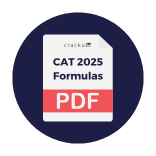Edit MetaData
Educational materials for IPMAT and IIMB UG preparation
Welcome to Adda
9 years, 8 months ago
please explain me cubes concept in CAT portion briefly...i.e; about painted cubes...
- Copy Link
9 years, 8 months ago
Hi Upamanyu,
The following points are to be remembered:
1. When a cube is painted and cut into smaller cubes, only the cubes on the vertices of the big cube will have exactly three faces painted
2. Only the cubes on the edges (other than the cubes on the vertices) will have exactly two faces painted
3. Only the cubes on the faces of the big cube (other than the cubes on the edges and vertices) will have one face painted
4. The cubes that cannot be seen are the cubes that will have no face painted
In general, for an n X n X n cube,
The total number of unit cubes is $$n^3$$.
The number of unit cubes which cannot be seen = number of unit cubes which have 0 faces painted = $$(n-2)^3$$.
The number of unit cubes which have exactly 3 faces covered by paint = 8.
The number of unit cubes which have exactly 2 faces covered by paint = 12*(n-2).
The number of unit cubes which have exactly one face covered by paint = 6*$$(n-2)^2$$.
In general, for a cuboid of dimensions p X q X r,
The total number of unit cubes = p*q*r.
The number of unit cubes which cannot be seen = number of unit cubes which have 0 faces painted = (p-2)*(q-2)*(r-2).
The number of unit cubes which have exactly 3 faces covered by paint = 8.
The number of unit cubes which have exactly 2 faces covered by paint = 4*(p-2) + 4*(q-2) + 4*(r-2).
The number of unit cubes which have exactly one face covered by paint = 2*(p- 2)*(q-2) + 2*(q-2)*(r-2) + 2*(r-2)*(p-2).



